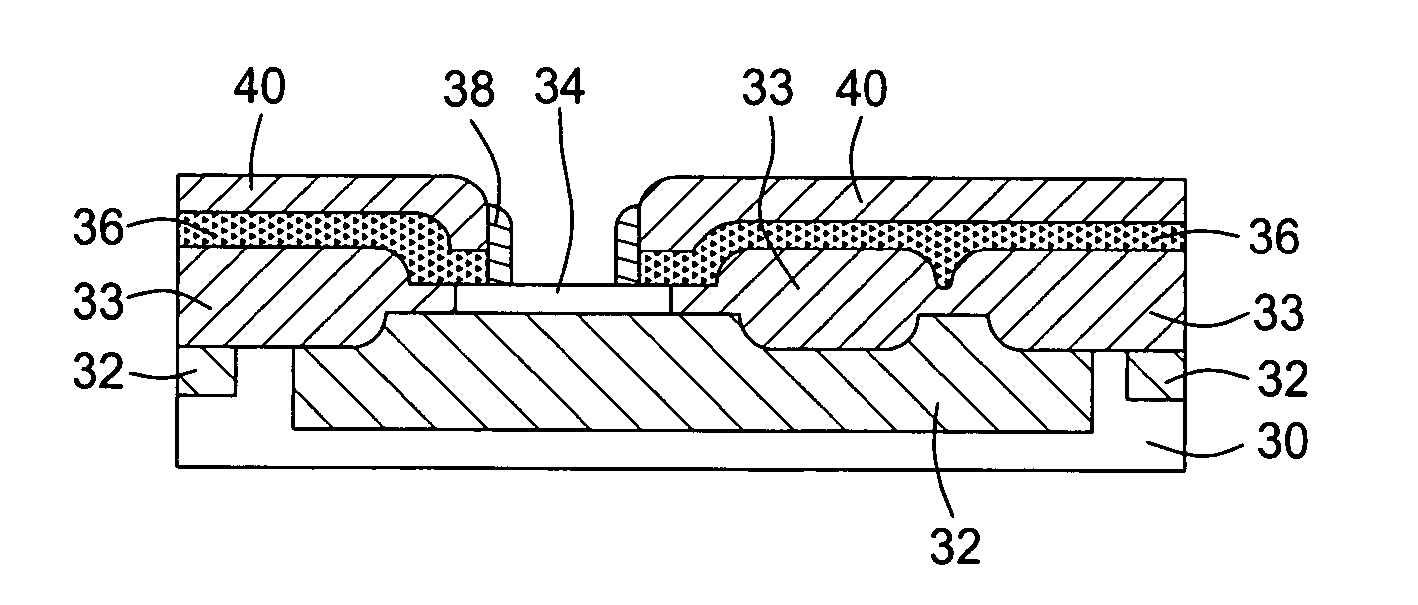Methods of selective deposition of heavily doped epitaxial SiGe
- Summary
- Abstract
- Description
- Claims
- Application Information
AI Technical Summary
Benefits of technology
Problems solved by technology
Method used
Image
Examples
example 1
Boron Doped Silicon Germanium Deposition
[0050] A substrate, Si, (e.g., 300 mm OD) was employed to investigate selective, monocrystalline film growth by CVD. A dielectric feature existed on the surface of the wafer. The wafer was prepared by subjecting to a 1% HF dip for 45 seconds. The wafer was loaded into the deposition chamber (Epi Centura® chamber) and baked in a hydrogen atmosphere at 800° C. for 60 seconds to remove native oxide. A flow of carrier gas, hydrogen, was directed towards the substrate and the source compounds were added to the carrier flow. Silane (100 sccm) and germane (6 sccm) were added to the chamber at 15 Torr and 725° C. Hydrogen chloride was delivered with a flow rate of 460 sccm. Diborane was delivered with a flow rate of 1 sccm. The substrate was maintained at 725° C. Deposition was carried out for 5 minutes to form a 500 Å SiGe film with a germanium concentration of 21 atomic percent and the boron concentration was 2.0×1020 cm−3.
example 2
Phosphorus Doped Silicon Germanium Deposition
[0051] A substrate was prepared as in Example 1. The wafer was loaded into the deposition chamber (Epi Centura® chamber) and baked in a hydrogen atmosphere at 800° C. for 60 seconds to remove native oxide. A flow of carrier gas, hydrogen, was directed towards the substrate and the source compounds were added to the carrier flow. Silane (100 sccm) and germane (4 sccm) were added to the chamber at 15 Torr and 725° C. Hydrogen chloride was delivered with a flow rate of 250 sccm. Phosphine was delivered to the chamber with a flow rate of 1 sccm. The substrate was maintained at 725° C. Deposition was carried out for 5 minutes to form a 500 Å SiGe film with a germanium concentration of 20 atomic percent and the phosphorus concentration was 1.6×1020 cm−3.
example 3
Boron Doped Silicon Germanium Deposition with Sequential Cl2SiH2 and SiH4 Flows
[0052] The substrates were prepared as in Example 1. The wafer was loaded into the deposition chamber (Epi Centura® chamber) and baked in a hydrogen atmosphere at 800° C. for 60 seconds to remove native oxide. A flow of carrier gas, hydrogen, was directed towards the substrate and the source compounds were added to the carrier flow. Dichlorosilane (100 sccm), germane (2.8 sccm), and diborane (0.3 sccm) were added to the chamber at 15 Torr and 725° C. Hydrogen chloride was delivered with a flow rate of 190 sccm. The substrate was maintained at 725° C. Deposition was conducted for 72 seconds to form a first layer of silicon compound with a thickness of 50 Å. On top of the first layer, a subsequent epitaxial layer (i.e., a second layer of silicon compound) was deposited using silane (100 sccm), germane (6 sccm), hydrogen chloride (460 sccm) and diborane (1 sccm). The chamber pressure and temperature remaine...
PUM
 Login to View More
Login to View More Abstract
Description
Claims
Application Information
 Login to View More
Login to View More - R&D
- Intellectual Property
- Life Sciences
- Materials
- Tech Scout
- Unparalleled Data Quality
- Higher Quality Content
- 60% Fewer Hallucinations
Browse by: Latest US Patents, China's latest patents, Technical Efficacy Thesaurus, Application Domain, Technology Topic, Popular Technical Reports.
© 2025 PatSnap. All rights reserved.Legal|Privacy policy|Modern Slavery Act Transparency Statement|Sitemap|About US| Contact US: help@patsnap.com



